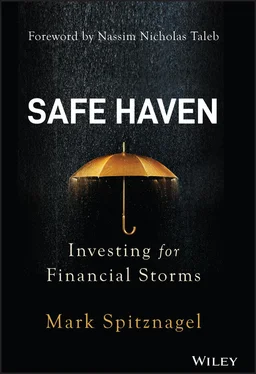We start with these first principles and use them as conceptual building blocks to eventually form deductive, testable hypotheses. While these first principles may sound obvious and sort of trivial at first, they are not. In fact, they are going to become really important as we explore some counterintuitive things about a pretty technical subject. They will allow us to change and even exploit the commonly held, though false, heuristics at the core of modern finance. They will even afford us a certain existential authenticity, allowing us to make our investing consistent with what we believe—to “bet our beliefs” as they say, despite all the external pressures to conform.
Principle number one is that investing is a process that happens sequentially through time.Investing is not static. It does not occur in just one interval of time, nor in many intervals of time aggregated together as one. (Albert Einstein purportedly noted that “the only reason for time is so that everything doesn't happen at once.”) Time is the medium through which life takes place, and so it is the medium through which investing takes place. We are stretched across time. Investing and risk are a multi‐period problem; and returns are an iterative, multiplicative process. They compound : In each period, we generally invest what we are left with from the last period. Like the geometric growth of offspring across generations, we parlay our capital . This principle fundamentally determines the nature of investing and the way we need to think about and interpret returns.
But as obvious as it is, just try telling that to a hedge fund manager whose incentive fee is based on annual performance: investing happens through time . Or, deliver that message to the pension fund that is harshly judged on its ability to meet an annual benchmark over the short term rather than over a timeline consistent with its beneficiaries. And try telling that to the economics and behavioral finance communities who label behavior “irrational” when it doesn't appear optimal within their single‐period, timeless framework. Do so and you should expect funny looks. But they criticize what they can't understand; they're no Einsteins. As for us, we need to ask ourselves every day: What is the meaning of time in investing? The answer, as you'll see, changes everything.
Principle number two is that there is only one explicit purpose or goal of investing, and that is to maximize our wealth over time.Period. This is exactly what we are trying to do with every additional, incremental decision that we make as investors. It is the target we shoot at. I'm not talking about the elusive mathematical expectation of wealth, nor our wealth relative to some arbitrary benchmark (though there are plenty of managers incentivized to care only about that). Rather, I'm talking about our actual realized ending wealth—meaning the outcome we're actually left with. (They are not the same.) This is equivalent to maximizing the rate that we grow or compound wealth over time—our compound annual growth rate, or CAGR. All investors are absolute return, compounding investors. I don't believe any thinking person, and certainly not any practitioner, should disagree with this principle. It is common sense.
And yet, some would still protest that the goal of investing should be to further humanity's progress, ease its burdens, do good to consumers and the world—and the profits will follow. But this is only another way of restating our principle. The consumer is the sovereign king whom capital must serve in order to be profitable; it is because of this that capital investment and entrepreneurship have objectively done more good for the world than any government or charity ever could.
Others might still protest that the goal of investing should be to maximize our wealth, given a certain level of theoretical risk taken. (This is where things would start to get a little muddled were it not for our next principle.) Since we know that risk mitigation is investing, we can deduce that the explicit purpose of risk mitigation is the very same as the explicit purpose of investing: to maximize the rate at which we compound our wealth over time—in other words, to cost‐effectively lower risk .
This leads to principle number three: If a risk‐mitigation strategy achieves its purpose by cost‐effectively lowering a portfolio's risk, then adding that strategy raises the portfolio's CAGR over time.
It makes sense. If we mitigate risk effectively by constraining it deliberately, shouldn't the point be to experience less loss as a result, such that over time we end up making more? And if we don't end up making more, will we still be glad we did it? What would the point have been? Is there any other reason to mitigate risk?
Risk mitigation, when done well, should provide a tangible, positive economic effect relative to its cost. That is, it should be cost‐effective, and thus a good value proposition. Accordingly, a risk‐mitigation strategy should be evaluated based on its degree of cost‐effectiveness at lowering risk—not just on its effectiveness at lowering risk.
Of course, we may have mitigated the risk of a remote, extreme loss that never happened. And yet, such a remote loss could happen suddenly at any time, and our risk mitigation could thus raise our CAGR (relative to our position had we not used that mitigation). This is the problem of induction, where the arrival of just one black swan falsifies any claim that all swans are white. But when I say that cost‐effective risk mitigation raises a portfolio's CAGR over time, this also means over a sufficiently broad range of observable outcomes, which largely resolves these epistemological problems. (We will address this with what is known as a bootstrap in later chapters.)
Amusingly, this principle that risk mitigation, done well, should raise our CAGR over time is actually quite controversial. In fact, most practitioners and academics would probably call it a crackpot idea. Lower risk comes at a cost, they believe, so risk mitigation is incompatible with higher returns.
To wit, one of the historic commodities trading houses had the German motto: “ Besser gut schlafen, als gut essen .” (“It is better to sleep well than to eat well.”) And academics claim that lower returns actually accompany lower risk or volatility as a consequence , ipso facto . Their story goes, as you hedge and diversify away all of your correlated and uncorrelated risks, respectively, your returns will approach the lowly risk‐free rate . Or going the other way, the academics argue that in order to induce an investor to hold an asset that is relatively volatile, its price drops until its expected return becomes high enough to justify the additional risk. In their world, it sounds reasonable, and it's a comfortable story, asserted but not proved: You've got to take more risk to make higher returns; sleeping well comes at a cost. No guts, no glory.
To make matters worse, academics furthered this idea by positing that investing and risk mitigation are about lowering or calibrating a portfolio's volatility relative to its average return—the risk‐adjusted return or dreaded Sharpe ratio —unwittingly at the expense of the growth rate of wealth. They thus claim an intellectually dishonest victory based on their own theoretical scoreboard. It is a solution in search of a problem, and a bad idea. (It's even a big reason for our great dilemma.) I don't really believe that most investors even have this bad idea. Rather, to paraphrase Carl Jung, the idea has them.
We need to measure our success as investors by the practical scoreboard that counts, rather than the theoretical ones that don't. And there is just one scoreboard that counts, just one bullseye.
Читать дальше












